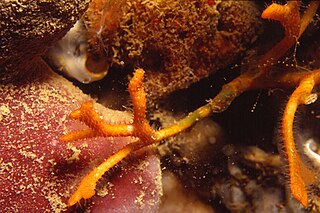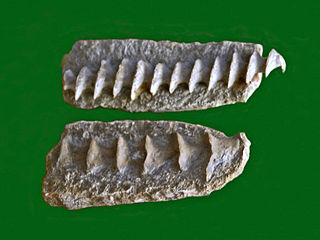Related Research Articles

Bryozoa are a phylum of aquatic invertebrate animals, nearly all forming sedentary colonies. Typically about 0.5 millimetres long, they are filter feeders that sieve food particles out of the water using a retractable lophophore, a "crown" of tentacles lined with cilia. Most marine species live in tropical waters, but a few occur in oceanic trenches, and others are found in polar waters. One class lives only in freshwater environments, and a few members of a mostly marine class prefer brackish water. 5869 living species are known. One genus is solitary and the rest are colonial.

Entoprocta, whose name means "rectum/anus inside", or Kamptozoa, is a phylum of mostly sessile aquatic animals, ranging from 0.1 to 7 millimetres long. Mature individuals are goblet-shaped, on relatively long stalks. They have a "crown" of solid tentacles whose cilia generate water currents that draw food particles towards the mouth, and both the mouth and anus lie inside the "crown". The superficially similar Bryozoa (Ectoprocta) have the anus outside a "crown" of hollow tentacles. Most families of entoprocts are colonial, and all but 2 of the 150 species are marine. A few solitary species can move slowly.
Stenolaemata are a class of marine bryozoans. This class originated in the Ordovician, and members still live today. All extant species are in the order Cyclostomatida.

Cheilostomatida is an order of Bryozoa in the class Gymnolaemata.
Membraniporidae is a bryozoan family in the suborder Malacostegina. Membranipora form encrusting or erect colonies; they are unilaminar or bilaminar and weakly to well-calcified. Zooids have vertical and basal calcified walls, but virtually no frontal calcified wall: most of the frontal surface is occupied by frontal membrane. An intertentacular organ is also present. The larvae are not brooded. The ancestrula is generally twinned. Kenozooids may be present in a few species; modified zooids analogous to avicularia are rare.

Cyclostomatida, or cyclostomes, are an ancient order of stenolaemate bryozoans which first appeared in the Lower Ordovician. It consists of 7+ suborders, 59+ families, 373+ genera, and 666+ species. The cyclostome bryozoans were dominant in the Mesozoic; since that era, they have decreased. Currently, cyclostomes seldom constitute more than 20% of the species recorded in regional bryozoan faunas.

A zooid or zoöid is a single animal that is part of a colonial animal. This lifestyle has been adopted by animals from separate unrelated taxa. Zooids are multicellular; their structure is similar to that of other solitary animals. The zooids can either be directly connected by tissue or share a common exoskeleton. The colonial organism as a whole is called a zoon, plural zoa.

Ascophora is an infraorder under order Cheilostomatida of the Bryozoa.
Anasca was a bryozoan sub-order under class Cheilostomida defined by the lack of an ascus in each zooid. It is no longer an accepted taxonomic grouping as it is considered a polyphyletic and/or paraphyletic grouping. The group is now subdivided into the suborders Inovicellata, Scrupariina, Malacostega, and Flustrina.

Flustrina is a suborder under the order Cheilostomatida of gymnolaematan Bryozoa.
The avicularium in cheilostome bryozoans is a modified, non-feeding zooid. The operculum, which normally closes the orifice when the zooids tentacles are retracted, has been modified to become a mandible. Strong muscles operate it. The polypide is greatly reduced, and the individual receives nourishment from neighboring zooids. The shape of the avicularian zooid can be identical to the feeding autozooid, but is usually elongated in the direction of the mandible.

The Smittinidae is a family within the bryozoan order Cheilostomatida. Colonies are encrusting on shells and rocks or upright bilaminar branches or sheets. The zooids generally have at least one adventitious avicularia on their frontal wall near the orifice. The frontal wall is usually covered with small pores and numerous larger pores along the margin. The ovicell, which broods the larvae internally, is double-layered with numerous pores in the outer layer, and sits quite prominently on the frontal wall of the next zooid.

The Stomachetosellidae is a family within the bryozoan order Cheilostomatida. Colonies are encrusting on shells and rocks or upright bilaminar branches or sheets. The zooids generally have at least one adventitious avicularia on their frontal wall near the orifice. The frontal wall is usually covered with small pores and numerous larger pores along the margin. The ovicell, which broods the larvae internally, is double-layered with numerous pores in the outer layer, and sits quite prominently on the frontal wall of the next zooid.

The Bitectiporidae is a family within the bryozoan order Cheilostomatida. Colonies are encrusting on shells and rocks or upright bilaminar branches or sheets. The zooids generally have at least one adventitious avicularia on their frontal wall near the orifice. The frontal wall is usually covered with small pores and numerous larger pores along the margin. The ovicell, which broods the larvae internally, is double-layered with numerous pores in the outer layer, and sits quite prominently on the frontal wall of the next zooid.
Beaniidae is a small bryozoan family in the cheilostomatan suborder Flustrina and superfamily Buguloidea. Their zooids have a weak box-like shell of calcium carbonate as most Flustrina, and in this family typically arranged disjunctly, connected by small tubes, and often boat-shaped. One species, Amphibiobeania epiphylla, is the only known amphibious bryozoan known as of 2008/09.

Archimedes is a genus of bryozoans belonging to the family Fenestellidae. The first use of the term "Archimedes" in relation to this genus was in 1838.
Conopeum seurati is a species of colonial bryozoan in the order Cheilostomatida. It is native to the northeastern Atlantic Ocean, the North Sea and the Mediterranean Sea. This species has been introduced to New Zealand and Florida.

Electra pilosa is a species of colonial bryozoan in the order Cheilostomatida. It is native to the northeastern and northwestern Atlantic Ocean and is also present in Australia and New Zealand.

Electra posidoniae is a species of bryozoan in the family Electridae. It is endemic to the Mediterranean Sea, and is commonly known as the Neptune-grass bryozoan because it is exclusively found growing on seagrasses, usually on Neptune grass, but occasionally on eelgrass.
Callopora lineata is a species of colonial bryozoan in the family Calloporidae. It is found on rocky shores in the Atlantic Ocean and the Mediterranean Sea.
References
- ↑ "GLOSSARY FOR THE BRYOZOA". www.bryozoa.net. Retrieved 12 December 2015.
- ↑ Dick, Matthew; Lidgard, Scott; Gordon, Dennis; Mawatari, Shunsuke (2009). "The origin of ascophoran bryozoans was historically contingent but likely". Proceedings. Biological Sciences. 276 (1670): 3141–8. doi:10.1098/rspb.2009.0704. PMC 2817133 . PMID 19515659.
| | This bryozoan-related article is a stub. You can help Wikipedia by expanding it. |